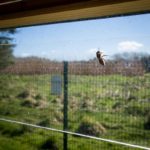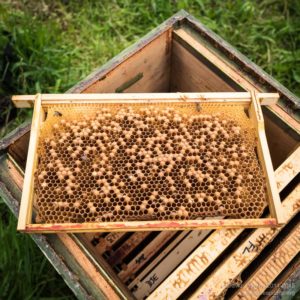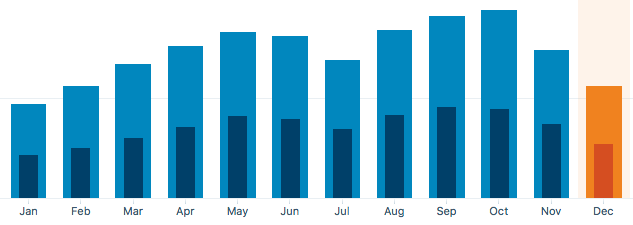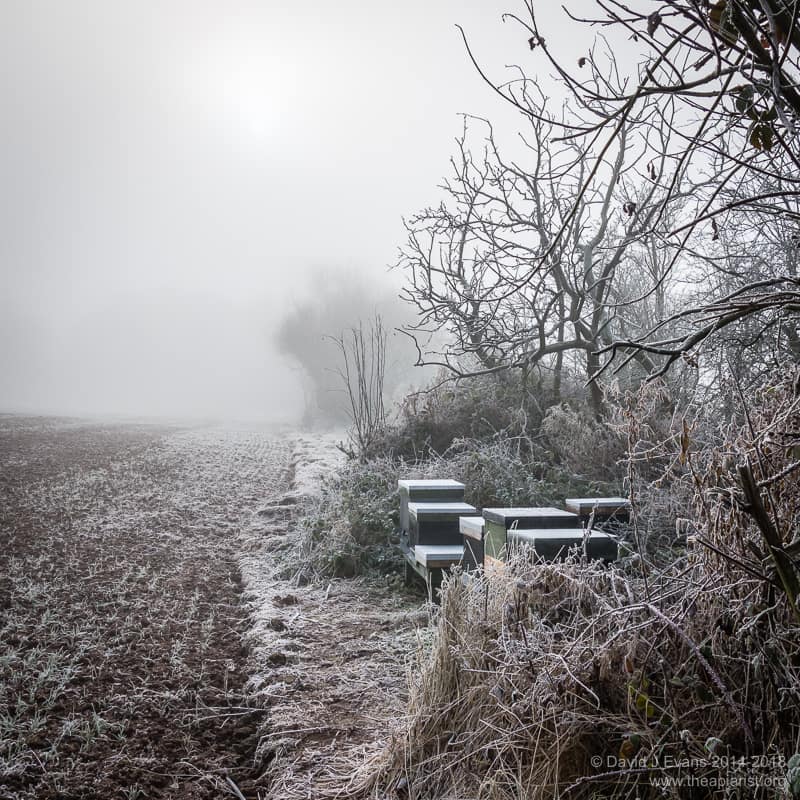2016 in retrospect
The end of another year and another season’s beekeeping. Now is a good time to review what went well and what went badly.
In terms of my beekeeping year in Scotland, the end of December isn’t even half way through the winter. Although I didn’t open many hives after mid-September (three and a half months ago), unless we get a warm, early Spring I don’t expect to do any inspections until mid-April. That’s another four and a half months to ruminate on the year passed and plan for the season ahead.
The high points
This was the first full season using the bee shed and I’m already convinced of the advantages it offers. Colonies built up well in the late Spring, appreciably faster than colonies in the same apiary that didn’t benefit from the protection the shed offers. I was able to inspect whatever the weather. Only really warm days were a problem, and that was because it gets uncomfortably hot. The Up-and-Out™ windows (the bees crawl up and fly out) clear the shed very quickly, making it a good environment for grafting larvae when queen rearing without getting buzzed with bees all the time. It would benefit from power, better lighting, a kettle and an armchair … perhaps something to plan for 2017? It’s never going to resemble the palatial setups in some of those German bee houses, but in terms of secure, weatherproof and sheltered accommodation, it’s hard to beat.
Varroa control has worked well this year. A combination of timely applications of treatment and a significant brood break in the middle of the season, meant that colonies went into the winter with low to very low Varroa levels. Some broodless colonies dropped less than 20 mites after midwinter treatment which is very encouraging.
I’ve also been pleased with the honey flavour this year. By missing the OSR – too cold (the photo above was taken at the end of April) – the early season honey was a heady mix of goodness knows what, and all the better for it. Great flavour and it has sold well. The switch to square jars with distinctive black lids looks good and, coupled with a very simple DIY label, it’s been popular with repeat customers. My honey is currently available – assuming they haven’t sold out over Christmas – from Mellis Cheese in St. Andrews and Edinburgh, and Luvians in Cupar.
The low points
The most significant problems were all related to queens. Firstly, queens from 2015 were poorly mated (as predicted way back in June 2015) and several gave up (stopped laying) or simply disappeared in May/June. Secondly, my own queen rearing coincided with shortfall and an extended period of very poor weather for queen mating. As a consequence, several hives developed laying workers and needed some significant interventions to rescue them.
All of these problems – some of my own making, but some unavoidable – meant that production colonies weren’t really strong enough to exploit the summer nectar flow. Honey yields from the summer were the worst I’ve had for half a decade, though the flavour was outstanding. I’ve a couple of 30lb buckets left that I’m hoping to eke out over the next few weeks in the smallest possible portions. To add insult to injury … it was apparently one of the best years for heather honey and, because of the problems detailed above, I was singularly unprepared to take advantage of it. In all honesty, I’m not wildly disappointed about this as I’m not a great fan of heather honey. However, since I’m in Scotland and heather honey is considered by many as the crème de la crème, I feel I’ve missed a golden opportunity.
The new season
With the winter solstice now passed it’s time to make plans for the coming season. I’ll deal with these in the Spring as this article is already longer than intended.
www.theapiarist.org
It’s been a busy year with posts almost every Friday. This was more than I’d intended at the beginning of the year, but seems to have happened without too much contrivance. Although posted on a Friday, they’re written in the days and weeks preceding (hence explaining the butchered tenses often used).
I’ve always tried to avoid the diary-like cataloguing of what goes on in the apiary (as there are others who do this much better), instead focusing on a balance between topical items and more expansive posts – often written as separate linked articles (like on Varroa control or queen rearing) – that both reflect my interests and might help others improve their beekeeping … if only by avoiding my mistakes 😉
Other than a slightly odd dip in July – a belated “June gap”? – visitor numbers and page views showed the expected pattern of increasing interest in mid/late Spring, tailing off again as the season draws to a close. The peak figures in October reflect the interest in feeding fondant and mite treatments. Clearly there’s still some work to do … treating for mites in October is likely to be too late to protect the winter bees from the ravages of deformed wing virus. Over the entire year the original 2014 posting about honey warming cabinets remained the most popular, with articles on feeding fondant, vertical splits, steam wax extractors and foundationless frames getting lots of attention as well.
Search and ye shall find …
Google and most other search engines ‘hide’ the search terms used by viewers to reach a website. This is nominally valuable information, though looking at the terms that do get through the filters makes you wonder … each of the terms below led the viewer to this site (the typos are original) :
circular large 200 frame honey extractor plans … as opposed to a small 200 frame extractor?
wellies with honey bee pucturers on … puctures?
using laser printer in unheated wooden shed … electric heater needed I think
square drones frame homemaking striping images … random word generator?
foundationless sheds … understandable considering foundationless frames and bee sheds
poly queen beekeeping pdf … article on poly queen beekeeping in preparation for 2017
plastic nuc boxes for sale in manitoba … perhaps a little too geographically specialised
simple label design for honey sales in nigeria … see Manitoba
do i feed bees with apiguard … not exactly
is dettol effective against varroa mites … rigorous testing needed and possibly tainted honey?
how to treat a double brood hive with api bioxal … article on beekeeping bankruptcy to follow
houney bees kb shed bnati h or kb kha jays h … yes, that really was a search term
save humanity … a topic covered in detail earlier this year
humanity save … there’s a theme emerging here
how do bees save humanity … by pretending to be wasps
Unsocial media
It’s clear that there are whole communities of beekeepers out there with very different online activities – some interchangeably use old-fashioned websites (like this site) and various types of social media, others restrict themselves to Twitter and Facebook. Posts to this site are now also ‘announced’ on Twitter (@The_Apiarist) and Facebook. I still have to get the hang of Facebook as I’ve not previously used it … I don’t even know how to properly link to it 🙁
Anyway … enough for the year. As I write this the winter solstice has now passed, the days will be getting longer and lighter, queens will – particularly now with the warmer winter weather – be starting to lay and mites will be starting to reproduce. There’s very little to do in the apiary, but the new season is definitely on its way …
For 2017 I hope your bees are gentle, your queens are prolific, your supers are heavy and your swarms end up in my bait hives 😉
Happy New Year







Join the discussion ...